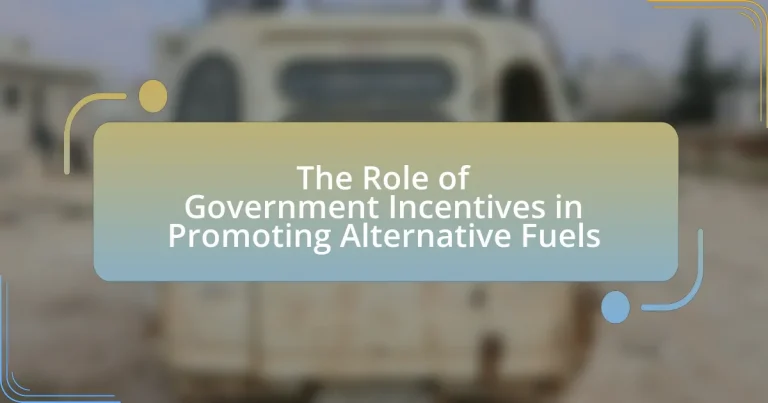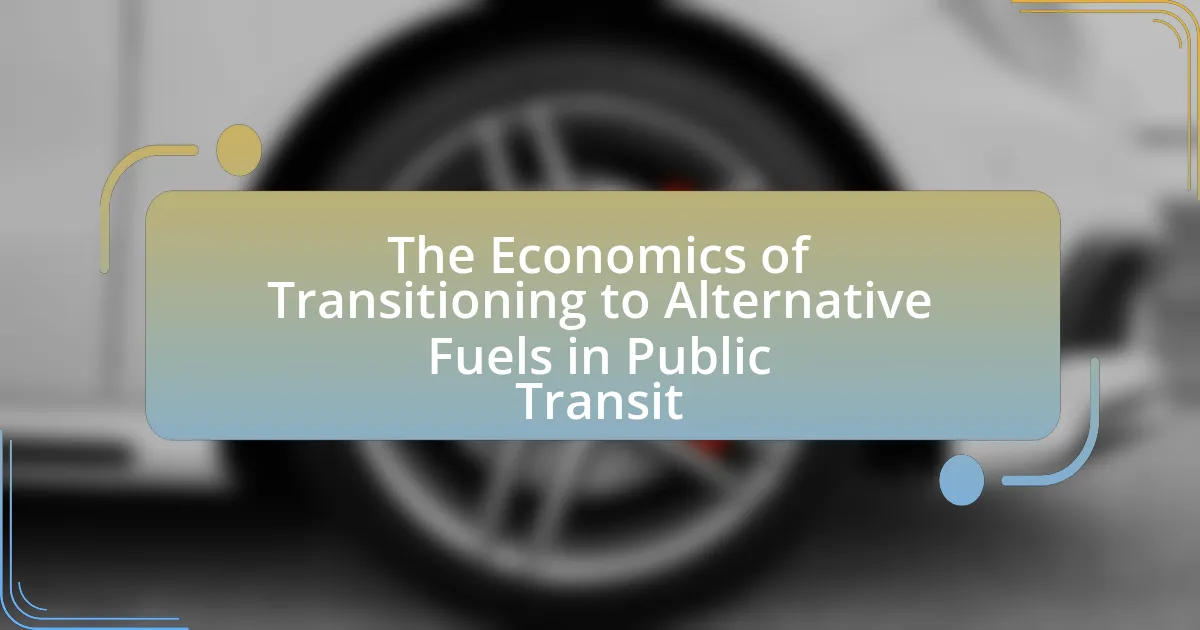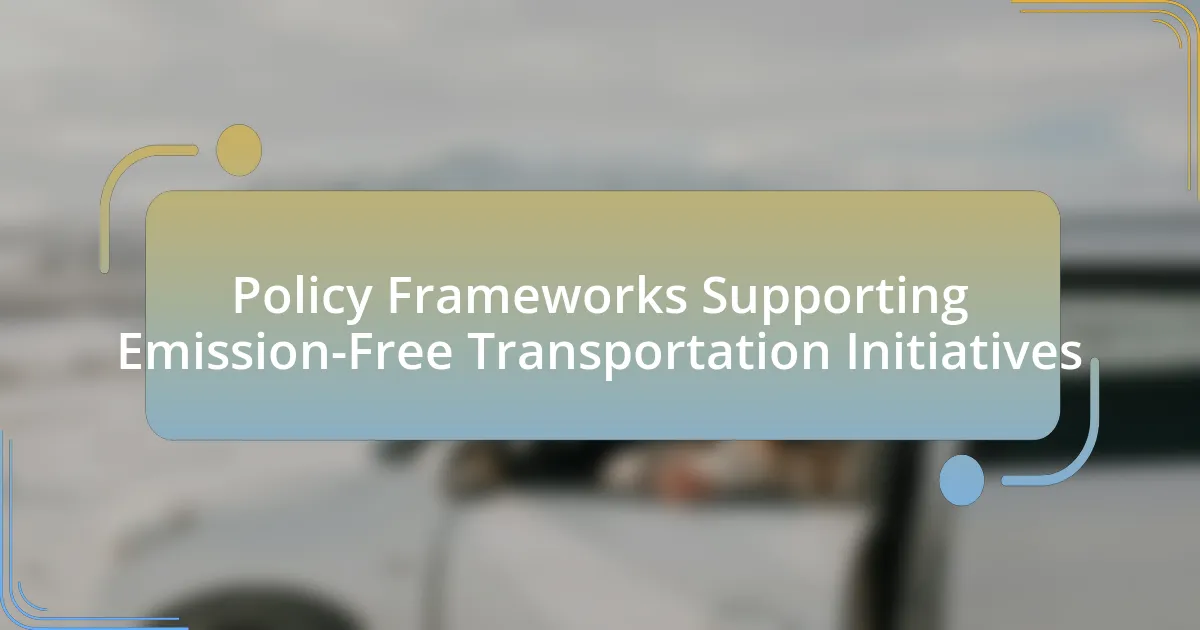The article focuses on the role of government incentives in promoting alternative fuels, highlighting various financial mechanisms such as tax credits, grants, and subsidies that encourage the adoption of renewable energy sources. It discusses the effectiveness of programs like the Renewable Fuel Standard and the Investment Tax Credit in increasing market share for alternative fuels, reducing greenhouse gas emissions, and stimulating economic growth. Additionally, the article examines the challenges faced by alternative fuels without government support, the economic and environmental benefits of these incentives, and best practices for their implementation, providing a comprehensive overview of how government policies can drive the transition to cleaner energy solutions.
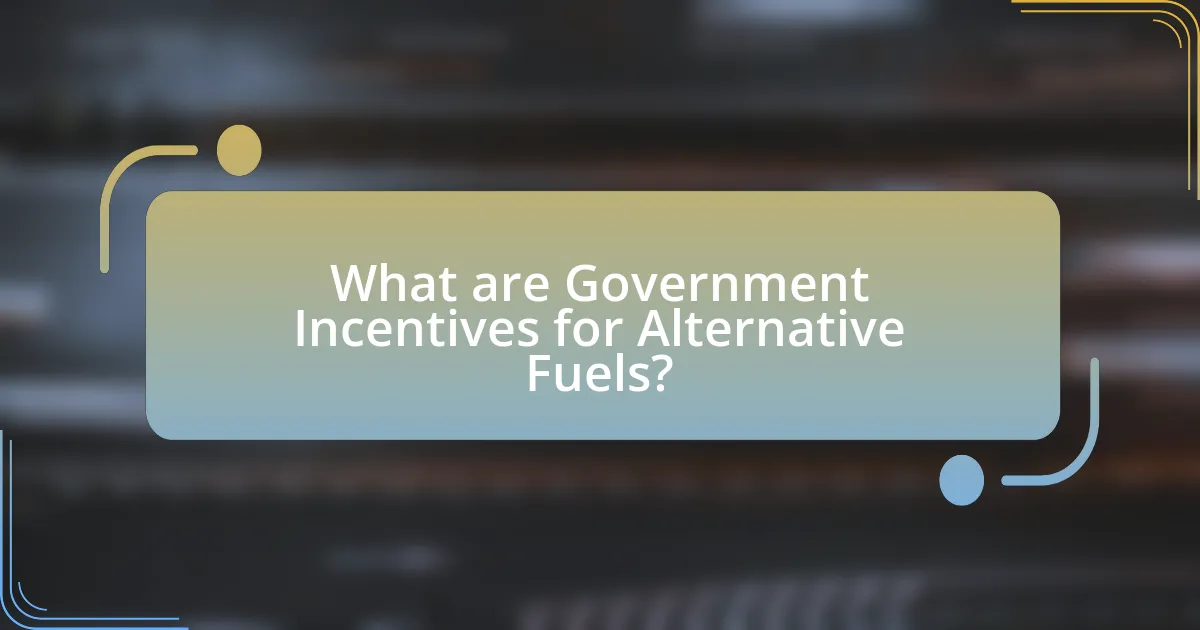
What are Government Incentives for Alternative Fuels?
Government incentives for alternative fuels include tax credits, grants, and subsidies aimed at promoting the use of renewable energy sources. For instance, the federal government in the United States offers the Renewable Fuel Standard (RFS), which mandates the blending of renewable fuels into the transportation fuel supply, thereby encouraging production and consumption of alternative fuels. Additionally, the Investment Tax Credit (ITC) provides a tax credit for solar energy systems, while the Production Tax Credit (PTC) supports wind energy projects. These incentives are designed to reduce greenhouse gas emissions, decrease reliance on fossil fuels, and stimulate economic growth in the renewable energy sector.
How do government incentives promote the use of alternative fuels?
Government incentives promote the use of alternative fuels by providing financial support and regulatory advantages that lower the cost and increase the accessibility of these energy sources. For instance, tax credits, grants, and subsidies reduce the initial investment required for consumers and businesses to adopt alternative fuels, making them more competitive with traditional fossil fuels. According to the U.S. Department of Energy, programs like the Renewable Fuel Standard and the Clean Cities initiative have successfully increased the market share of alternative fuels by incentivizing their production and use, leading to a significant rise in biofuel consumption and electric vehicle adoption.
What types of incentives are commonly offered by governments?
Governments commonly offer financial incentives, tax credits, grants, and subsidies to promote alternative fuels. These incentives aim to reduce the cost of adopting cleaner energy sources, thereby encouraging businesses and consumers to transition from fossil fuels. For instance, the U.S. federal government provides a tax credit for electric vehicles, which can amount to $7,500, significantly lowering the purchase price and stimulating market demand. Additionally, various states offer grants for renewable energy projects, such as solar and wind, to further support the development of alternative fuel technologies.
How do these incentives vary across different countries?
Government incentives for promoting alternative fuels vary significantly across countries, influenced by local policies, economic conditions, and environmental goals. For instance, in Norway, substantial tax exemptions and subsidies for electric vehicles have led to over 54% of new car sales being electric in 2021, showcasing a strong commitment to reducing carbon emissions. In contrast, the United States employs a federal tax credit of up to $7,500 for electric vehicles, but the effectiveness varies by state due to differing local incentives and regulations. Additionally, countries like Germany offer a combination of purchase incentives and investment in charging infrastructure, while India focuses on subsidies for manufacturing electric vehicles and promoting biofuels. These variations reflect each country’s unique approach to energy transition and environmental sustainability.
Why are government incentives necessary for alternative fuels?
Government incentives are necessary for alternative fuels to stimulate market adoption and reduce reliance on fossil fuels. These incentives, such as tax credits, grants, and subsidies, lower the financial barriers for consumers and businesses, making alternative fuel technologies more accessible. For instance, the U.S. federal government offers a tax credit of up to $7,500 for electric vehicles, which has significantly increased their sales and adoption rates. Additionally, research from the International Energy Agency indicates that government support can accelerate the transition to renewable energy sources, highlighting the critical role of incentives in achieving energy security and environmental goals.
What challenges do alternative fuels face without government support?
Alternative fuels face significant challenges without government support, primarily due to high initial costs and lack of infrastructure. The development and deployment of alternative fuel technologies often require substantial investment, which can be prohibitive for private companies without government subsidies or incentives. For instance, the U.S. Department of Energy reported that the upfront costs for biofuel production can be up to 50% higher than conventional fuels, making it difficult for these alternatives to compete in the market. Additionally, the absence of government-backed infrastructure, such as refueling stations for electric or hydrogen vehicles, limits consumer access and adoption. According to a study by the International Energy Agency, countries with strong government support for alternative fuels have seen a 30% increase in adoption rates compared to those without such support.
How do incentives impact the adoption rates of alternative fuels?
Incentives significantly enhance the adoption rates of alternative fuels by reducing financial barriers for consumers and businesses. For instance, tax credits, rebates, and grants lower the upfront costs associated with purchasing alternative fuel vehicles and infrastructure, making them more attractive options. A study by the International Council on Clean Transportation found that countries offering substantial incentives saw adoption rates of electric vehicles increase by over 50% compared to those without such programs. This demonstrates that financial incentives directly correlate with higher adoption rates, as they encourage consumers to transition from traditional fuels to alternatives.
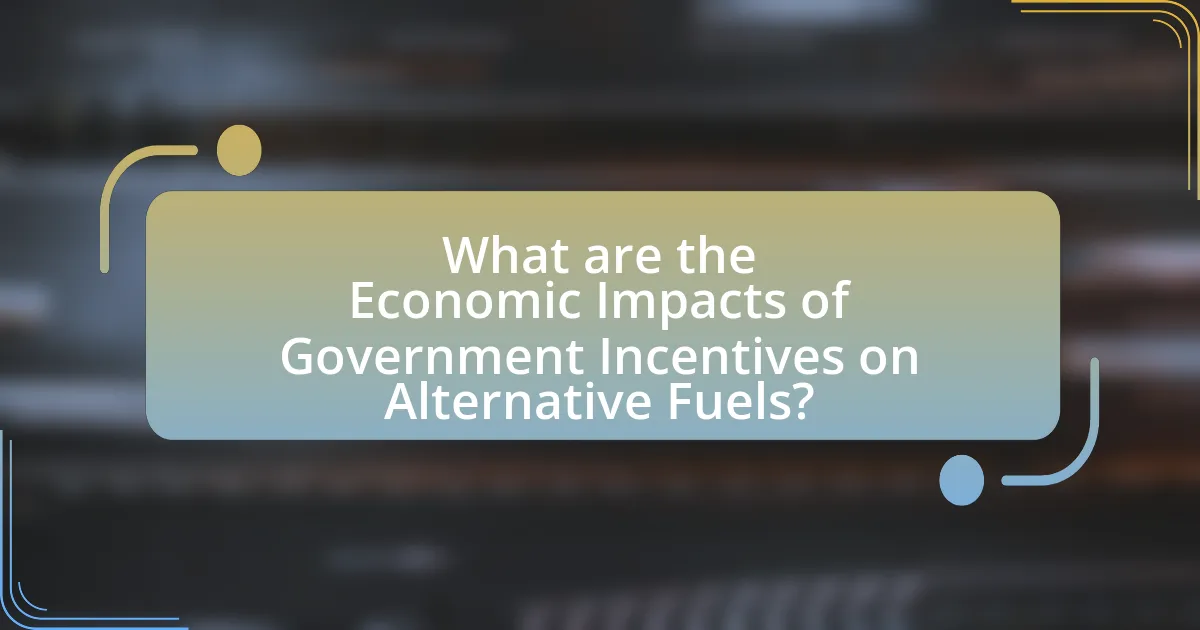
What are the Economic Impacts of Government Incentives on Alternative Fuels?
Government incentives on alternative fuels significantly stimulate economic growth by increasing investment, creating jobs, and reducing dependency on fossil fuels. For instance, the U.S. federal tax credit for electric vehicles, which offers up to $7,500 per vehicle, has led to a surge in electric vehicle sales, contributing to a market growth of over 200% from 2015 to 2020. Additionally, incentives for biofuels have encouraged the establishment of new production facilities, resulting in over 100,000 jobs in the biofuel sector as reported by the Renewable Fuels Association. These economic impacts demonstrate that government incentives effectively drive innovation and market expansion in the alternative fuels industry.
How do government incentives affect the market for alternative fuels?
Government incentives significantly boost the market for alternative fuels by lowering production costs and increasing consumer demand. These incentives, such as tax credits, grants, and subsidies, encourage manufacturers to invest in alternative fuel technologies, making them more competitive against traditional fossil fuels. For instance, the U.S. federal government offers a tax credit of up to $7,500 for electric vehicle purchases, which has led to a substantial increase in electric vehicle sales, with a reported 200% growth from 2017 to 2021. Additionally, state-level incentives, like California’s Low Carbon Fuel Standard, have further stimulated the market by promoting cleaner fuel alternatives, resulting in a 30% increase in alternative fuel use in the state. Thus, government incentives play a crucial role in shaping the alternative fuels market by fostering innovation and enhancing consumer adoption.
What role do incentives play in reducing costs for consumers?
Incentives play a crucial role in reducing costs for consumers by making alternative fuels more financially accessible. Government incentives, such as tax credits, rebates, and grants, lower the upfront costs associated with purchasing alternative fuel vehicles or installing renewable energy systems. For example, the U.S. federal tax credit for electric vehicles can reduce the purchase price by up to $7,500, directly impacting consumer affordability. Additionally, these incentives can stimulate market competition, leading to lower prices as manufacturers innovate and improve efficiency. Studies have shown that regions with robust incentive programs experience higher adoption rates of alternative fuels, further driving down costs through economies of scale.
How do incentives influence investment in alternative fuel technologies?
Incentives significantly influence investment in alternative fuel technologies by reducing financial risks and enhancing profitability for investors. Government subsidies, tax credits, and grants lower the initial capital required for developing and deploying these technologies, making them more attractive to investors. For instance, the U.S. federal government offers a tax credit of up to $7,500 for electric vehicle purchases, which has spurred substantial investments in electric vehicle technology and infrastructure. Additionally, research from the International Renewable Energy Agency indicates that countries with robust incentive programs, such as feed-in tariffs and renewable energy certificates, have seen a marked increase in renewable energy investments, demonstrating that financial incentives effectively drive capital towards alternative fuel technologies.
What are the long-term economic benefits of promoting alternative fuels?
Promoting alternative fuels yields significant long-term economic benefits, including reduced dependence on fossil fuels, job creation in new energy sectors, and lower greenhouse gas emissions leading to potential cost savings in climate-related damages. By investing in alternative fuels, economies can diversify their energy sources, which enhances energy security and stabilizes prices against volatile fossil fuel markets. According to a report by the International Renewable Energy Agency, the renewable energy sector employed over 11 million people globally in 2018, with projections indicating continued growth as alternative fuels gain traction. Additionally, transitioning to alternative fuels can lead to substantial public health savings by reducing air pollution, which the American Lung Association estimates costs the U.S. economy over $150 billion annually in healthcare expenses.
How do government incentives contribute to job creation in the alternative fuel sector?
Government incentives significantly contribute to job creation in the alternative fuel sector by providing financial support and tax benefits that stimulate investment and innovation. These incentives, such as grants, subsidies, and tax credits, lower the financial barriers for companies developing alternative fuel technologies, encouraging them to expand operations and hire more workers. For instance, the U.S. Department of Energy reported that investments in renewable energy and energy efficiency can create up to 1.3 million jobs by 2030, demonstrating the direct correlation between government support and employment growth in this sector.
What is the potential for economic growth through alternative fuel adoption?
The potential for economic growth through alternative fuel adoption is significant, as it can lead to job creation, innovation, and reduced dependence on fossil fuels. According to a report by the International Renewable Energy Agency (IRENA), the renewable energy sector employed over 11 million people globally in 2018, with projections indicating that this number could rise to 24 million by 2030 if alternative fuels are widely adopted. Additionally, the transition to alternative fuels can stimulate technological advancements, as companies invest in research and development to improve efficiency and reduce costs. This shift not only enhances energy security but also contributes to environmental sustainability, which can attract investments and foster economic resilience.
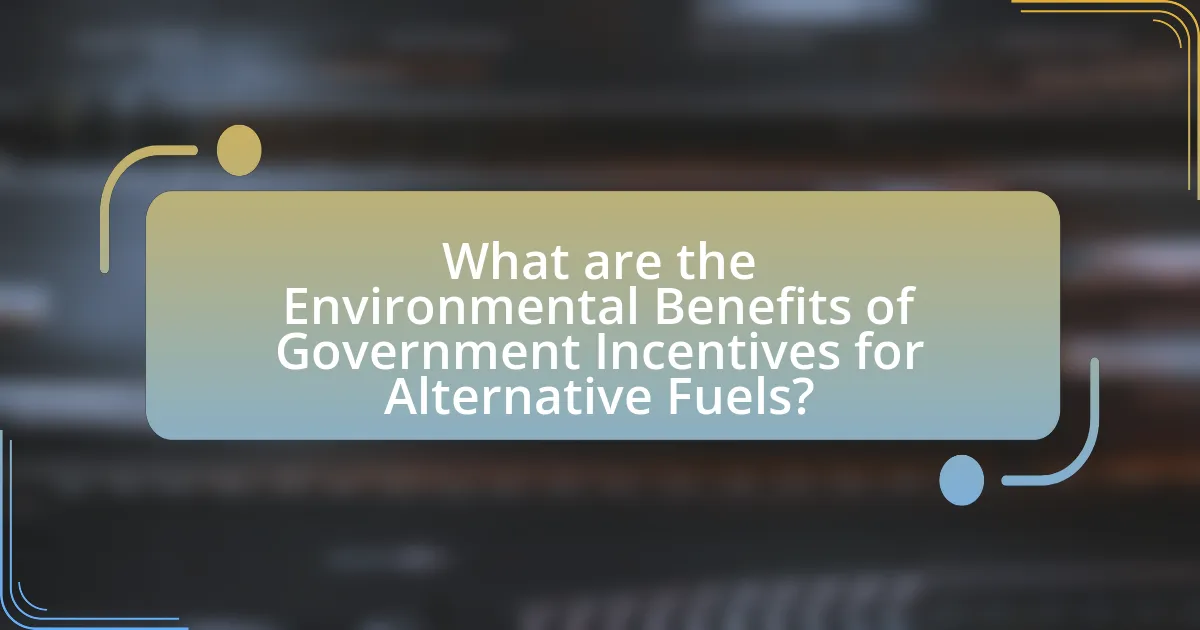
What are the Environmental Benefits of Government Incentives for Alternative Fuels?
Government incentives for alternative fuels significantly reduce greenhouse gas emissions and air pollutants. By promoting the use of cleaner energy sources, such as biofuels, electric vehicles, and hydrogen, these incentives help transition away from fossil fuels, which are major contributors to climate change. For instance, a study by the U.S. Department of Energy found that increasing the adoption of alternative fuels could reduce carbon dioxide emissions by up to 80% compared to traditional gasoline and diesel. Additionally, government incentives can lead to improved air quality, as alternative fuels typically produce fewer harmful emissions, resulting in better public health outcomes.
How do alternative fuels contribute to reducing greenhouse gas emissions?
Alternative fuels significantly reduce greenhouse gas emissions by providing cleaner energy sources that emit fewer pollutants compared to traditional fossil fuels. For instance, biofuels, such as ethanol and biodiesel, can lower carbon dioxide emissions by up to 86% compared to gasoline and diesel, respectively, according to the U.S. Department of Energy. Additionally, electric vehicles powered by renewable energy sources like wind or solar can eliminate tailpipe emissions entirely, contributing to a substantial decrease in overall greenhouse gas output. The adoption of alternative fuels is further supported by government incentives, which encourage the transition from high-emission fuels to more sustainable options, thereby enhancing their impact on reducing greenhouse gas emissions.
What specific environmental impacts are mitigated by alternative fuels?
Alternative fuels mitigate several specific environmental impacts, primarily reducing greenhouse gas emissions, air pollutants, and dependence on fossil fuels. For instance, biofuels can lower carbon dioxide emissions by up to 86% compared to conventional gasoline, as demonstrated in studies by the U.S. Department of Energy. Additionally, alternative fuels such as compressed natural gas (CNG) produce significantly fewer nitrogen oxides and particulate matter, contributing to improved air quality. Furthermore, the use of renewable energy sources like solar and wind for electric vehicles decreases reliance on fossil fuels, thereby reducing habitat destruction associated with oil extraction and transportation.
How do government incentives enhance the environmental benefits of alternative fuels?
Government incentives enhance the environmental benefits of alternative fuels by providing financial support and regulatory advantages that encourage their adoption and use. These incentives, such as tax credits, grants, and subsidies, lower the cost barrier for consumers and businesses, making alternative fuels more competitive with traditional fossil fuels. For instance, the U.S. federal government offers a tax credit for electric vehicles, which has significantly increased their sales and reduced greenhouse gas emissions. According to the U.S. Department of Energy, the adoption of alternative fuels can lead to a reduction of up to 50% in carbon emissions compared to conventional fuels. Thus, government incentives play a crucial role in accelerating the transition to cleaner energy sources, ultimately enhancing their environmental benefits.
What role do government incentives play in achieving sustainability goals?
Government incentives play a crucial role in achieving sustainability goals by providing financial support and regulatory frameworks that encourage the adoption of environmentally friendly practices. These incentives, such as tax credits, grants, and subsidies, lower the cost barrier for businesses and consumers to invest in sustainable technologies, including alternative fuels. For instance, the U.S. federal government offers a tax credit for electric vehicles, which has significantly increased their market penetration, contributing to reduced greenhouse gas emissions. Additionally, studies show that countries with robust government incentives for renewable energy, like Germany, have seen a substantial increase in renewable energy capacity, demonstrating the effectiveness of such policies in driving sustainability initiatives.
How do incentives align with international climate agreements?
Incentives align with international climate agreements by encouraging countries and businesses to reduce greenhouse gas emissions and adopt sustainable practices. These incentives, such as tax breaks, subsidies, and grants, are designed to make compliance with climate agreements more economically viable. For instance, the Paris Agreement promotes financial mechanisms that support developing nations in transitioning to low-carbon technologies, thereby aligning economic interests with environmental goals. Research shows that countries implementing such incentives have seen increased investments in renewable energy, which is crucial for meeting international climate targets.
What are the implications of government incentives for future energy policies?
Government incentives significantly shape future energy policies by promoting the adoption of alternative fuels and technologies. These incentives, such as tax credits, grants, and subsidies, encourage investment in renewable energy sources, thereby accelerating the transition from fossil fuels to cleaner alternatives. For instance, the U.S. federal government allocated approximately $29 billion in tax incentives for renewable energy projects in 2020, which directly influenced the growth of solar and wind energy sectors. As a result, energy policies are increasingly designed to support sustainability goals, reduce greenhouse gas emissions, and enhance energy security, reflecting a broader commitment to combating climate change.
What are best practices for implementing government incentives for alternative fuels?
Best practices for implementing government incentives for alternative fuels include establishing clear objectives, ensuring stakeholder engagement, and providing consistent funding. Clear objectives help define the goals of the incentive program, such as reducing greenhouse gas emissions or increasing energy independence. Engaging stakeholders, including industry representatives, environmental groups, and the public, fosters collaboration and ensures that the incentives meet diverse needs. Consistent funding is crucial for the long-term success of these programs, as it allows for sustained investment in alternative fuel technologies. For example, the U.S. federal government has successfully implemented tax credits for electric vehicles, which have significantly boosted sales and adoption rates, demonstrating the effectiveness of well-structured incentives.
